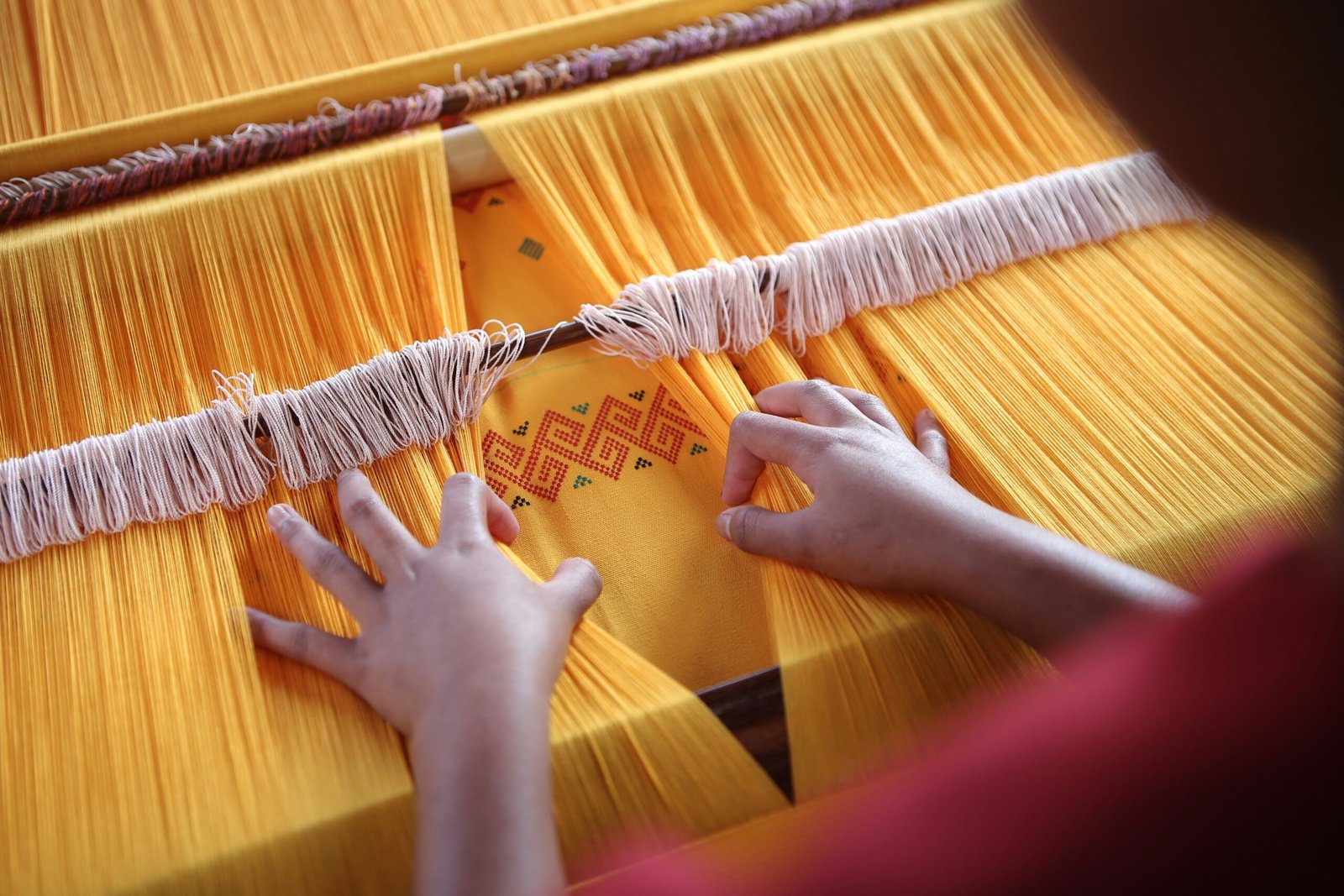
Introduction to Chiang Mai’s Silk Road
Chiang Mai, nestled in the mountainous regions of northern Thailand, stands as a captivating symbol of cultural heritage, particularly in the realm of traditional silk weaving. The city, known for its rich history and vibrant arts scene, has long been a significant hub within the broader context of the Silk Road, a historic network of trade routes that connected diverse cultures and economies. Established in the 13th century and flourishing under the Lanna Kingdom, Chiang Mai’s strategic location enabled it to become a meeting point for merchants and artisans, facilitating the exchange of not only goods but also artistic ideas and techniques.
The importance of silk weaving in Chiang Mai cannot be overstated. It is an art form that has been passed down through generations, reflecting the unique identity and traditions of the local communities. The region is renowned for its high-quality silk products, which are intricately designed and handcrafted by skilled artisans. Traditional weaving villages, such as San Kamphaeng and Baan Tawai, are pivotal in preserving these age-old techniques while providing a glimpse into the lifestyle and culture of the local population. These villages serve as both production centers and cultural custodians, often welcoming visitors to witness the weaving process and explore the craftsmanship behind each piece of silk fabric.
In recent years, Chiang Mai’s silk industry has gained international recognition, enabling local artisans to connect with global markets and showcase their exquisite creations. The intersection of tradition with contemporary fashion trends has resulted in a vibrant scene where traditional weaving artistry is integrated into modern designs. Thus, understanding the significance of Chiang Mai’s Silk Road era is essential, as it highlights the profound impact of traditional weaving on both local culture and the broader fashion industry.
Historical Background of Silk Weaving in Chiang Mai
Silk weaving in Chiang Mai boasts a rich history that intertwines tradition and evolution, reflecting the region’s cultural tapestry shaped by various influences. The roots of silk weaving in this northern Thai city can be traced back to the Lanna Kingdom, which flourished from the 13th to the 18th centuries. During this period, Chiang Mai emerged as a vital cultural and economic hub, attracting artisans who brought their skills and dialects, ultimately infusing the local craftsmanship with diverse techniques and patterns.
The development of silk weaving in Chiang Mai saw significant milestones, particularly with the establishment of trade routes that connected the region to neighboring countries, including Myanmar and China. This trade facilitated not only the exchange of goods but also the fusion of artistic ideas and weaving techniques. As merchants and travelers brought new materials and styles, local weavers began to adapt and innovate, leading to the creation of distinct silk textiles that echoed the cultural heritage of both Lanna and its cross-border neighbors.
Furthermore, the ethnic diversity of Chiang Mai has played a vital role in shaping its silk weaving tradition. Various ethnic groups, including the Khmu, Hmong, and Shan, each contributed unique motifs and storytelling methods to the weaving process, enriching the fabric of Chiang Mai’s silk industry. Cultural exchanges during festivals and trade also allowed for the proliferation of traditional techniques that continue to inform contemporary practices today. This historical canvas highlights how the intertwining influences of trade, ethnicity, and cultural exchanges have resulted in a flourishing silk weaving craft that endures as a vibrant aspect of Chiang Mai’s heritage.
The Weaving Villages of Chiang Mai
Chiang Mai, renowned for its rich cultural heritage, is home to several weaving villages that have preserved traditional textile crafts for generations. Among these, San Kamphaeng and Bo Sang stand out for their distinctive techniques and products. San Kamphaeng, often labeled the silk capital of Northern Thailand, specializes in silk weaving. Artisans utilize locally sourced silk threads, producing exquisite textiles famed for their sheen and durability. The villagers showcase their skills through an intricate weaving process that involves hand-operated wooden looms, allowing for unique designs that reflect the vibrant culture of the region.
In contrast, Bo Sang is celebrated for its production of traditional parasols and cotton textiles. This village is characterized by its use of hand-painted designs, often drawing inspiration from nature and local traditions. Artisans in Bo Sang employ natural dyes derived from local flora, resulting in stunning, eco-friendly products that signify both craftsmanship and sustainability. The parasols, not only practical but also aesthetic, are often associated with the region and have gained global recognition, showcasing the craftsmanship of Bo Sang artisans.
Each village boasts a rich tapestry of stories from the skilled artisans dedicating their lives to these traditional practices. Many artisans belong to families who have been weaving for generations, passing down techniques and patterns that have become integral to their local identity. Through community workshops and exhibitions, these weavers not only share their expertise but also promote an appreciation for traditional craftsmanship among visitors. This relationship between community and craft plays a significant role in sustaining the vibrant weaving culture of Chiang Mai.
Techniques and Processes of Traditional Weaving
The art of traditional silk weaving is a meticulous process that showcases the remarkable craftsmanship of artisans in Chiang Mai’s weaving villages. This intricate craft begins with the selection of raw materials, primarily silkworm cocoons. The quality of silk threads is largely determined by the health and diet of the silkworms, which primarily feed on mulberry leaves. Once the cocoons are harvested, they undergo a series of steps starting with boiling to soften the fibers, making it easier to extract the silk threads.
After extraction, the silk threads are spun into skeins. This spinning process is performed using a traditional hand spindle or a more modern spinning wheel, depending on the artisan’s choice. The resulting threads are then prepared for dyeing. Natural dyes, derived from plants, minerals, and insects, offer vibrant colors that have been utilized for generations. Artisans often use techniques like tie-dye or batik to create unique patterns before weaving begins.
The weaving itself is a skilled process, traditionally done on a hand-operated loom. The loom is a vital tool in this craft, consisting of various components including the warp beam, heddles, and weft. Weavers meticulously arrange the threads and use their deft hands to create intricate designs, often inspired by the cultural heritage and symbolism of the region. This phase is where the weaver’s experience and artistic expression come to life, with patterns that preserve the identity of their community.
Throughout generations, these weaving techniques have been passed down, preserving not just the skills but also the stories attached to each piece of fabric. The result is high-quality textiles that not only showcase the beauty of silk but also represent a rich cultural history, making each finished product a unique work of art.
Cultural Significance of Silk Weaving
The art of silk weaving in Thailand, notably in Chiang Mai, holds profound cultural significance that transcends mere aesthetics and utility. It is an integral aspect of Thai identity and tradition, encapsulating the rich tapestry of beliefs, rituals, and community values. The creation of silk fabric is often intertwined with spiritual practices, where local artisans invoke blessings and reverence for their craft. Each piece woven often embodies the stories passed down through generations, reflecting not only the individual artisan’s skills but also the collective heritage of the community.
Silk weaving serves as a medium through which local traditions and spiritual beliefs are expressed. The patterns and colors used in the weaving carry symbolic meanings, often associated with nature, folklore, and auspiciousness. It is common for artisans to create specific designs for significant life events such as weddings and religious ceremonies, imbuing the garments with cultural narratives and spiritual significance. For instance, vibrant silk garments are traditionally worn during festivals and ceremonies, showcasing the artistry and spirituality that permeates Thai silk weaving. These garments are not merely clothing; they are cultural artifacts that resonate with the history and values of the community.
The importance of silk garments extends beyond ceremonial contexts; they play a vital role in everyday life. In local communities, wearing traditional silk fabric signifies a person’s connection to their heritage and often evokes a sense of pride in their cultural roots. During significant milestones, such as weddings, silk garments are donned to honor customs and traditions, making them indispensable in expressing one’s cultural identity. Thus, the cultural significance of silk weaving is manifold, serving as both a testament to Thai craftsmanship and a vital component of community identity.
Modern Adaptations and the Fashion Industry
In recent years, the traditional weaving techniques of Chiang Mai’s villages have experienced a resurgence, leading to a significant integration into the contemporary fashion industry. These adaptations not only preserve age-old craftsmanship but also allow local artisans to contribute meaningfully to modern aesthetics. Collaborations between traditional weavers and fashion designers showcase a unique synthesis of old and new, creating garments that appeal to both local and international markets.
Fashion designers are increasingly turning to the rich tapestry of Chiang Mai’s weaving traditions, recognizing the value of the skills and stories embedded within each textile. By reinterpreting traditional patterns, colors, and techniques, they craft contemporary pieces that resonate with today’s consumers while respecting cultural heritage. Such collaborations often prioritize sustainable practices, ensuring that the environmental impact of production is minimized, thus appealing to the eco-conscious fashion market.
Additionally, the influence of tourism plays a crucial role in these modern adaptations. As tourists flock to Chiang Mai, there is a growing demand for unique, authentic products that tell a story. This demand encourages artisans to innovate and adapt their craft to meet the expectations of a global audience while retaining the traditional essence of their work. The result is a vibrant fusion of fashion that celebrates cultural diversity and craftsmanship. Events such as fashion shows that highlight these collaborations further spotlight the skill of local weavers and their contribution to modern fashion.
By bridging the gap between traditional weaving and contemporary fashion, these adaptations not only enrich the fashion industry but also empower local communities. Artisans are now positioned as key players in the modern economy, fostering a newfound appreciation for the artistry of traditional techniques. This evolution is essential for ensuring the future of Chiang Mai’s weaving legacy within the global fashion landscape.
Touring Chiang Mai’s Weaving Villages
Chiang Mai is renowned for its rich tapestry of culture, and its weaving villages stand as prominent showcases of traditional craftsmanship. For travelers eager to explore these vibrant communities, planning your visit can enhance the experience significantly. Generally, the villages are accessible via either rental vehicles or organized tours, with popular options being the San Kamphaeng and Bo Sang villages which are located within a short drive from the city center.
Upon arrival, visitors will find an immersive environment where time-honored techniques are prevalent. Each village offers a unique insight into the weaving process, and as such, travelers should anticipate viewing artisans at work. This hands-on experience exemplifies the dedication behind each piece, making it an enriching educational opportunity.
Key attractions in these villages include workshops that offer demonstrations of silk weaving, dyeing, and other related crafts. Engaging in a weaving workshop can be particularly fulfilling as it allows tourists to create their own souvenirs while gaining firsthand experience in these traditional techniques. Additionally, local shops in the vicinity often stock a variety of handmade products, including silk scarves, tablecloths, and garments. These items not only serve as beautiful mementos but also support the local economy.
When planning your visit, it is advisable to check the operating hours of the workshops and shops as they may vary. Also, ensure that you have cash on hand, as many artisans prefer not to accept cards. While exploring, don’t forget to interact with the locals, who often share fascinating stories about their craft and heritage. Such exchanges can enrich your experience and provide a deeper understanding of the cultural significance of these weaving villages.
Sustainability and Ethical Fashion in Weaving
The fashion industry is often scrutinized for its environmental impact, particularly due to the rise of fast fashion, which prioritizes rapid production and consumption over ethical considerations. This phenomenon contributes significantly to waste, pollution, and exploitation of labor. In contrast, traditional silk weaving practices, as seen in Chiang Mai’s weaving villages, present a compelling counter-narrative that emphasizes sustainability and ethical fashion.
Traditional silk weaving relies on time-honored techniques that have been passed down through generations. These practices typically involve using natural dyes and locally sourced materials, which minimizes the ecological footprint compared to mass-produced garments. The commitment to sustainable practices not only helps preserve the environment but also enriches the cultural heritage of the communities involved. By investing in local artisans, consumers can support ethical fashion that respects both the environment and the workers’ rights.
Furthermore, the support for traditional weaving contributes to fair trade practices that ensure artisans receive a fair wage for their labor. This economic sustainability is crucial in empowering local communities, especially women, who are often the primary weavers. By choosing products made from traditional silk, consumers contribute to the viability of these crafts, helping to protect livelihoods and maintain the socio-cultural integrity of the region.
The importance of sustainable fashion extends beyond aesthetics; it embodies a philosophy that prioritizes mindful consumption and respect for cultural traditions. By promoting awareness about the value of traditional silk weaving, we can foster a deeper understanding of fashion’s role in environmental conservation and community support. Ultimately, embracing sustainable practices in our fashion choices can lead to a more equitable and environmentally conscious industry.
Conclusion: The Future of Traditional Weaving in Chiang Mai
The relevance and vitality of traditional silk weaving in Chiang Mai face significant challenges as modernity pervades every facet of life. Artisans, who have dedicated their lives to this meticulous craft, find themselves in an increasingly competitive environment dominated by mass-produced textiles. This industrialization has not only altered consumers’ purchasing habits but has also diminished the appreciation for the intricate artistry encapsulated in traditional handwoven fabrics. The allure of convenience and lower prices often overshadow the cultural significance and craftsmanship found in locally produced silk.
However, despite these challenges, there are numerous initiatives and programs designed to preserve this invaluable cultural heritage. Local governments and NGOs are collaborating with artisans to provide trainings and resources that enhance their skills and marketing strategies. These efforts aim to promote the uniqueness of traditional weaving, encouraging both local and international markets to recognize and support authentic craftsmanship. Cultivating a renewed interest in traditional textiles is essential; consequently, tourism has become a powerful vehicle for change, as visitors seek to engage with local artisans and their work. Workshops and demonstrations not only enrich the tourist experience but also provide necessary exposure for these craftspeople.
To ensure the longevity of traditional weaving in Chiang Mai, it is vital for consumers to make conscious choices. Supporting local artisans through the purchase of their handcrafted products is crucial in sustaining their livelihoods and maintaining the cultural essence woven into each piece. Community awareness coupled with active participation in preserving and promoting these traditional skills will contribute to a sustainable future for silk weaving. By valuing these artisanal practices, we not only honor their historical significance but also ensure that future generations can experience the beauty of Chiang Mai’s silk weaving legacy.


